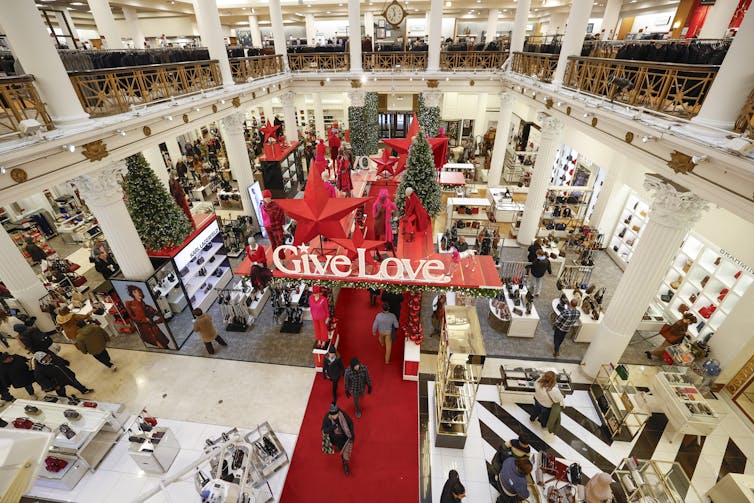Retailers that make it harder to return stuff face backlash from their customers
Even those consumers who said they usually don’t return any products often reacted negatively during an experiment that simulated what happens when shoppers face stricter rules.

In 2018, L.L. Bean ended its century-old “lifetime” return policy, limiting returns to one year after purchase and requiring receipts. The demise of this popular policy sparked backlash, with several customers filing lawsuits.
It also inspired my team of operations management researchers to study how customers respond when retailers make their return policies more strict. Our key finding: Whether they often or rarely return products they’ve purchased, consumers object – unless those retailers explain why.
I work with a group of researchers examining product return policies and how they affect consumers and retailers.
As we explained in an article published in the Journal of Operations Management, we designed experiments to study whether and why return policy restrictions irk customers. We also wanted to understand what retailers can do to minimize backlash after making it harder for customers to return stuff.
We conducted three experiments in which we presented scenarios to 1,500 U.S. consumers who played the role of loyal customers of a fictional retailer. We examined their reactions to the fictional retailer’s return policy restrictions, such as charging a 15% restocking fee and limiting open-ended return windows to 365, 180 and 30 days.
Participants became less willing to buy anything from the fictional retailer after it restricted its long-standing lenient return policy. They also said they would become less willing to recommend the retailer to others.
This occurred because the customers began to distrust the retailer and its ability to offer a high-quality service. The backlash was stronger when the restriction was more severe. Even those consumers who said they usually don’t return any products often reacted negatively.
When the fictional retailer announced its new, harsher return policy using official communication channels and provided a rationale, there was less backlash. Consumers found the changes more justified if the retailer highlighted increased “return abuse,” in which customers return products they’ve already used, or the high cost of processing returns.
You might presume that making it harder and more costly to return stuff could drive some shoppers away. Our research shows that the concern is valid and explains why. It also shows how communicating return policy changes directly with customers can help prevent or reduce backlash against retailers.

Why it matters
Americans returned products worth an estimated US$890 billion to retailers in 2024. Processing a single item typically costs $21 to $46. Most of this merchandise ends up in landfills.
The rise of e-commerce and other technological changes have contributed to this trend. Another factor is the ease with which consumers may return stuff long after making a purchase and get a full refund.
Many other retailers besides L.L. Bean have done away with their long-standing lenient return policies. Over the past decade, for example, Macy’s, a department store chain, and Kohl’s, a big-box clothing store chain, have shortened the time frames for returns.
Macy’s restricted its open-ended return window to one year in 2016, further winnowed it to 180 days in 2017, then to 90 days in 2019. It then stopped accepting returns after 30 days in 2023. Kohl’s didn’t have any time limit on returns it would accept until 2019. Then it imposed a 180-day limit. Others, such as fast-fashion giants Zara and H&M, now charge their customers fees when they return merchandise.
However, research shows that customers value no-questions-asked return policies and see them as a sign of high-quality service. And when these arrangements become the industry standard, customers can get angry if retailers fail to meet it.
Interestingly, most retailers that restricted their policies didn’t tell customers directly. Instead, they quietly updated the new policies on websites, store displays and receipts. Although not drawing attention to bad news might appear prudent – as most customers wouldn’t notice the changes that way – dozens of threads on Reddit about these changes suggest that this isn’t always true.
What still isn’t known
We focused on restrictions on refunds and how long after a purchase customers could return merchandise. Other restrictions, such as retailers making heavily discounted items ineligible for returns, could also be worth investigating.
The Research Brief is a short take about interesting academic work.
Huseyn Abdulla does not work for, consult, own shares in or receive funding from any company or organization that would benefit from this article, and has disclosed no relevant affiliations beyond their academic appointment.
Read These Next
As US hunger rises, Trump administration’s ‘efficiency’ goals cause massive food waste
Despite the administration’s claim of streamlining the government to make its operations more efficient,…
A year on, the Israeli-Lebanese ceasefire looks increasingly fragile − could a return to cyclical vi
Since the start of the truce on Nov. 27, 2024, there have been thousands of Israeli violations inside…
A database could help revive the Arapaho language before its last speakers are gone
Many Native American languages only have a few native speakers left.





